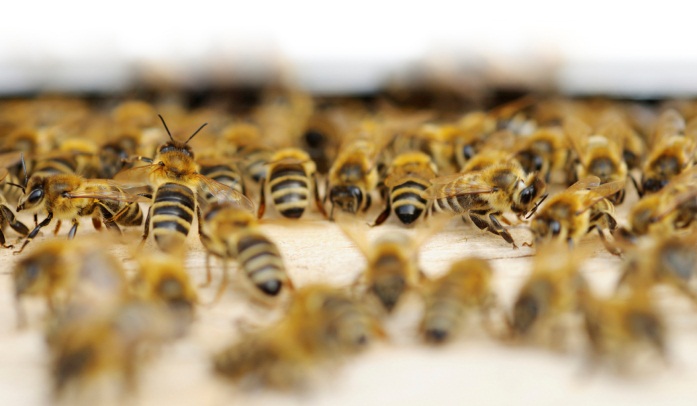30
Mar
Multiple Pesticides Detected in Poisoned Bees
(Beyond Pesticides, March 30, 2016) European researchers found over 50 different types of pesticides in honey bees while investigating more than 70 honey bee poisoning incidents. Their study, which detected neonicotinoids, pyrethroids, fipronil, and others, highlights the large number of toxic pesticides to which bees are exposed in the environment from agricultural fields to home gardens. The study results add to the body of knowledge connecting bee poisoning to pesticide exposure.
 The study, which is a multi-residue analysis to determine pesticides in honey bees from poisoning incidents, was published in the Journal of Chromatography by a team of researchers from the National Veterinary Research Institute in Poland. 57 pesticides were found in 73 samples of poisoned honey bees, with four pesticides on average, and up to 13 determined simultaneously in a honey bee sample. The compounds detected include 21 insecticides and their metabolites, 20 fungicides, 12 herbicides, 2 acaricides and 2 veterinary medicinal products metabolites. Among them, metabolites of imidacloprid, thiacloprid, fipronil, methiocarb and amitraz were found. Chlorpyrifos, clothianidin, dimethoate, and tebuconazole were most frequently detected. Of the herbicides detected only MCPA, 2,4-D and prosulfocarb were determined more than once.
The study, which is a multi-residue analysis to determine pesticides in honey bees from poisoning incidents, was published in the Journal of Chromatography by a team of researchers from the National Veterinary Research Institute in Poland. 57 pesticides were found in 73 samples of poisoned honey bees, with four pesticides on average, and up to 13 determined simultaneously in a honey bee sample. The compounds detected include 21 insecticides and their metabolites, 20 fungicides, 12 herbicides, 2 acaricides and 2 veterinary medicinal products metabolites. Among them, metabolites of imidacloprid, thiacloprid, fipronil, methiocarb and amitraz were found. Chlorpyrifos, clothianidin, dimethoate, and tebuconazole were most frequently detected. Of the herbicides detected only MCPA, 2,4-D and prosulfocarb were determined more than once.
The authors believe that the study results contribute to understanding adverse effects associated with cumulative risk, pesticide mixtures, and other environmental factors. They note that more information is needed to determine the levels of exposure that cause adverse effects in bees. Currently, the U.S. Environmental Protection Agency (EPA) does not evaluate pesticide mixtures and their cumulative impacts on honey bees or other organisms.
Tomasz Kiljanek, PhD, lead author of the study said: “Honeybee poisoning incidents are the tip of the iceberg. Even at very low levels, pesticides can weaken bees’ defense systems, allowing parasites or viruses to kill the colony. Our results will help expand our knowledge about the influence of pesticides on honey bee health, and will provide important information for other researchers to better assess the risk connected with the mix of current used pesticides.”
EPA’s recent pollinator assessment of the neonicotinoid imidacloprid, confirms the pesticide’s toxicity to bees and that its presence in the pollen and nectar of various crops can put bees at risk, while a U.S. Government Accountability Office (GAO) report recently concluded that U.S. regulatory agencies are falling short in addressing the multiple threats contributing to declining pollinators. A study by a team of scientists led by Dave Goulson, PhD, puts into perspective the state of bee health in relation to the numerous pressures they face in the modern world: chronic exposure to multiple interacting stressors, including pesticide exposure and reduced immune response, is driving honey bee colony losses and declines of wild pollinators. Scientists suggest taking steps to reduce stress on bees, incorporating flower-rich habitat into farmland, and reducing pesticide use through adopting more sustainable farming methods. Similarly, in February, a United Nation’s assessment of pollinators and the global food supply warned that many species of wild bees, butterflies and other pollinators are on a dangerous path toward extinction, further threatening the food supply if the causes of these declines, many of them human-made, are not halted. The assessment found that an estimated 16 percent of vertebrate pollinators are threatened with global extinction.
Previous studies have found that pesticides, especially the neonicotinoids, impair bees’ ability to learn, forage, navigate as well as communicate. These pesticides, which are highly toxic to bees, have also been found to impair bee’s immune systems, leaving them more susceptible to parasites and disease. Other studies detail impairments in the brains of exposed bees, specifically in the areas associated with learning and memory. The science has become increasingly clear that pesticides, either working individually or synergistically, play a critical role in the ongoing decline of honey bees.
Plan to attend Cultivating Community and Environmental Health, the 34th National Pesticide Forum, April 15-16, 2016 in Portland, ME to discuss pollinators and other local and national environmental concerns. Jonathan Lundgren, Ph.D., a senior USDA entomologist will join other top scientists and leaders who have stood up to protect human and environmental health, despite facing industry backlash and scientific suppression. Dr. Lundgren’s research on the harm that neonicotinoids pose to monarch butterflies reflects a growing scientific consensus that these chemicals present significant risks to declining pollinator populations. Registration, which includes access to all sessions as well as organic food and beverages, is $45 for grassroots activists, and $25 for students. Register online today.
All unattributed positions and opinions in this piece are those of Beyond Pesticides.
Source: Independent










